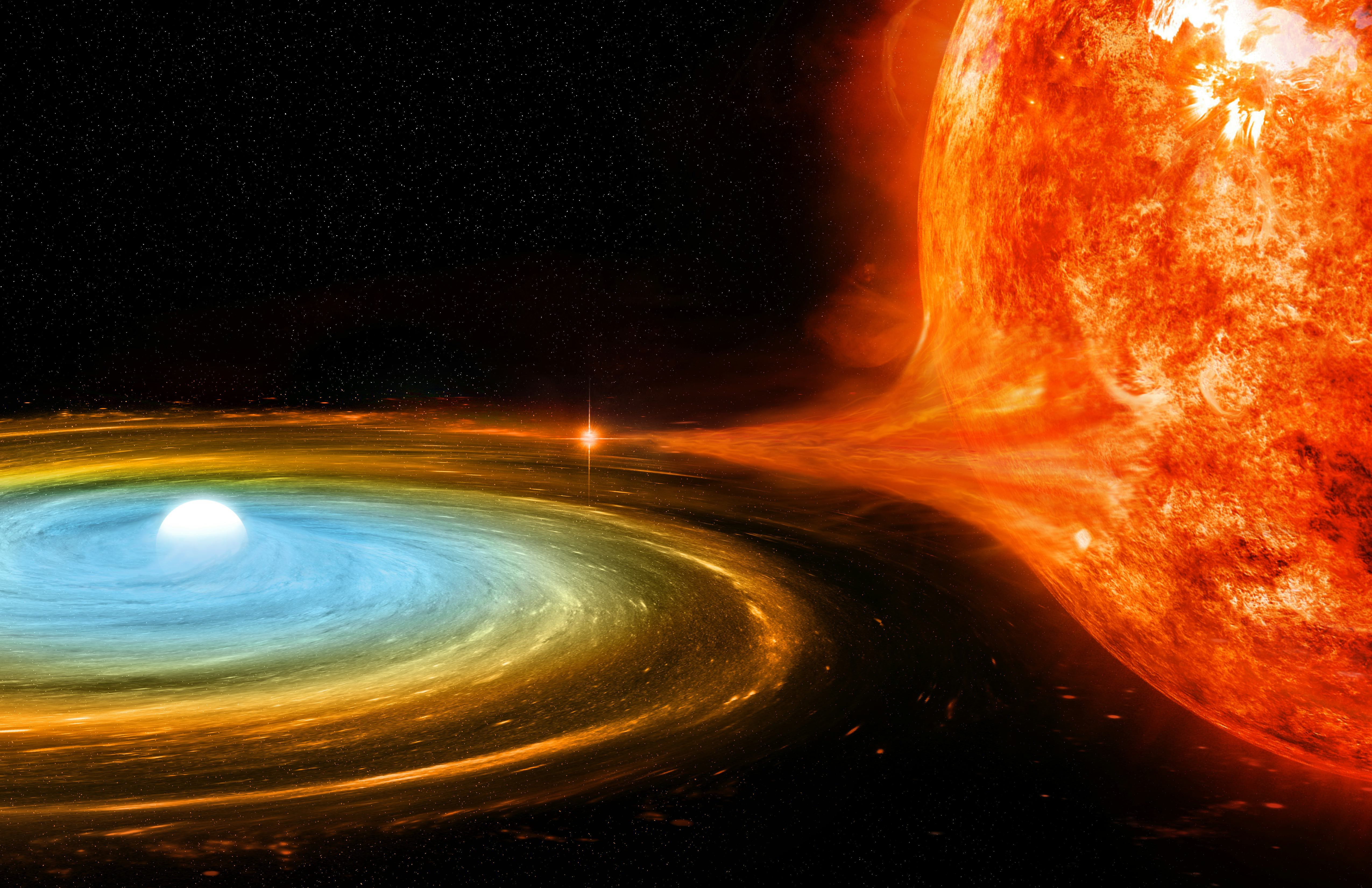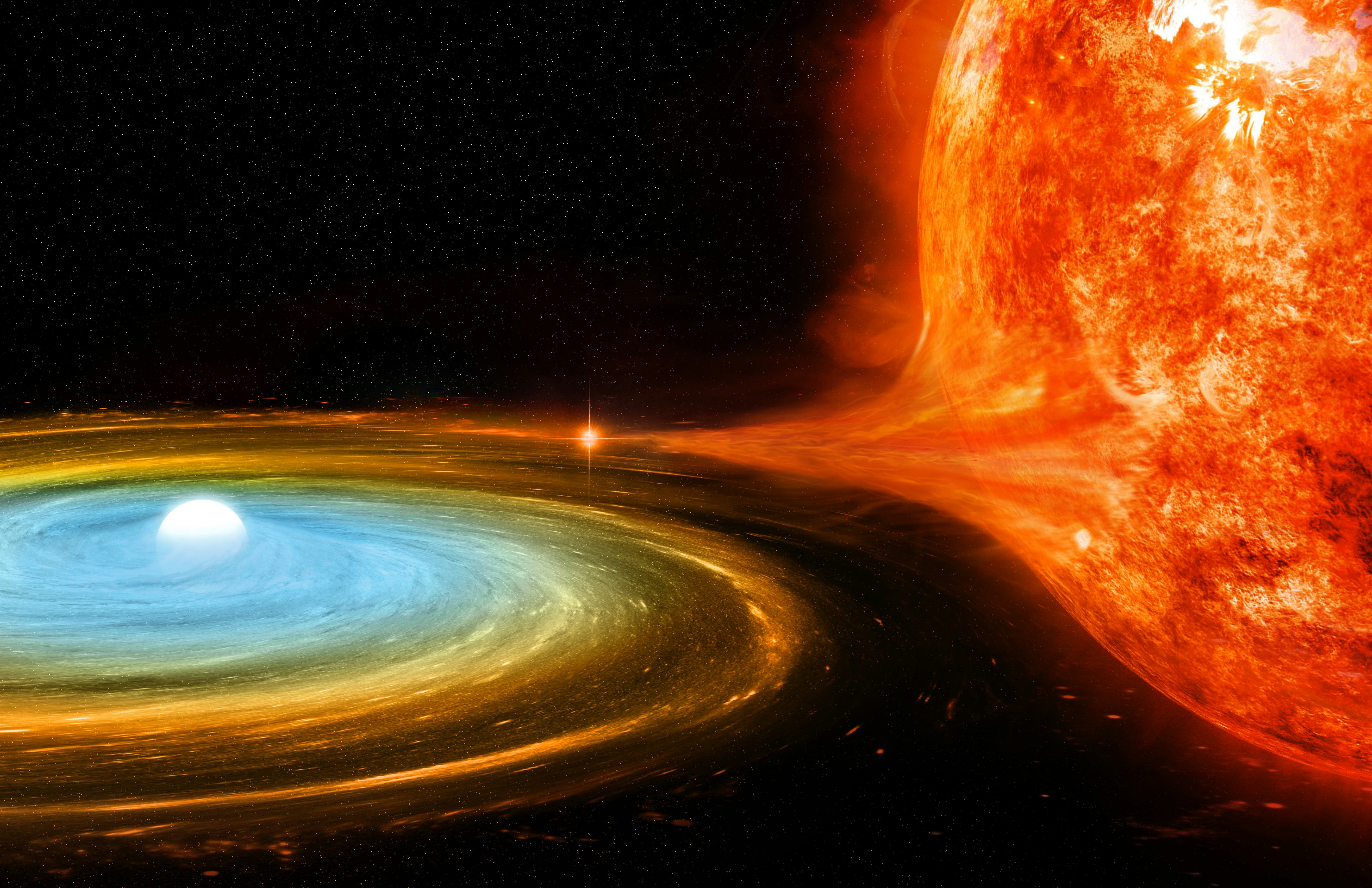
Astronomers recently spotted a Sun-like star orbiting ridiculously close to a white dwarf.
It’s the shortest such orbit ever detected — every 51 minutes, the Sun-like star whips around its white dwarf companion at a speed that is 15 percent the speed of light. And it holds clues about how these binary star systems evolve and produce gravitational waves.
They published their findings in the journal Nature.
What’s New – Massachusetts Institute of Technology astronomer Kevin Burdge and his colleagues could tell right away that they’d found a binary system: a pair of stars locked in orbit around a shared center of gravity. The two stars kept eclipsing each other’s light as they orbited. Based on the spectra of light the stars emitted (which contain clues about their makeup and temperature), as well as their mass and other data, the astronomers could tell they’d found a star about the mass and size of Jupiter (about 10 percent the mass and size of our Sun), orbiting a white dwarf about half the mass of our Sun and 1 percent of its size.
The two stars are close enough that the white dwarf’s gravity can pull hydrogen away from the upper layers of the star, increasing its own mass and shrinking its partner. Pairs of stars like this, trapped in an extremely one-sided relationship, are called cataclysmic variables. Astronomers bestowed the dramatic name because once in a while, these systems produce bright flashes of light when material falling onto the white dwarf gets dense enough to trigger a runaway thermonuclear reaction.
Cataclysmic variables aren’t rare in the galaxy, but in this one — named ZTF J1813+4251 — the partners circle each other so closely that they complete an orbit every 51 minutes. To pull that off, the star has to be zipping around its partner at around 15 percent of the speed of light. “The white dwarf orbits with a speed of about 100 kilometers per second (it moves more slowly because it is 5 times heavier than the star),” Burdge tells Inverse.
In fact, they orbit so close together that the constant rotation of their gravity makes waves that ripple out through the fabric of spacetime: gravitational waves.
Here’s the background – Astronomers have never before witnessed a cataclysmic variable like this one, where the stars orbit each other so close and so fast, yet the unwilling donor star is still burning through its hydrogen fuel.

They’ve seen systems where a hydrogen-burning star — like this one and like our own Sun — orbits its partner at a more respectful distance and a more sedate pace (once every hour and a half or more). And they’ve seen systems where the stars are daringly close and whirling around each other every few minutes, though only when one partner has run out of hydrogen and moved on to burning helium.
That’s because as a white dwarf draws material away from its hydrogen-burning partner, the stolen gas follows the star’s magnetic field lines in a big, curving arc toward its new home. And in the process, it drains energy from the stars’ whirling dance (so do the gravitational waves produced by their rotation). When that happens, both stars fall toward the shared center of gravity they’re orbiting. Closer orbits also mean shorter orbits, so it takes the stars less time to complete a single lap.
And the closer the stars get, the stronger the gravitational waves they produce, which drains away more energy, so they fall even closer together. By the time they’re close enough to complete an orbit in just a handful of minutes, the donor star has usually run out of hydrogen. That’s why the really close, fast-orbiting cataclysmic binaries tend to be a white dwarf and a helium-burning star.
Why it matters – Burdge and his colleagues describe this system as a sort of “missing link” between the two phases of a cataclysmic binary’s evolution, and they say it sheds light on how these systems evolve.
“This is a really special system because it tells us that gravitational wave sources like helium cataclysmic variables can come from stars that are gradually eaten away by a companion,” Burdge says. “This is a very different picture than what we normally think of (normally, we think they form through one star completely swallowing another in something called a common envelope event.”
And ZTF J1813+4251 suggests that the evolutionary path that produces cataclysmic variables on super-tight orbits may be less of a straight line and more of a group of branches that converge at a shared destination.
“The discovery of this system tells us that there are many different ways you can make binaries with such a short period and that there probably just isn't one generic pathway for forming them all,” says Burdge.
What’s Next – In about 70 million years, the dynamic duo of ZTF J1813+4251 will fall even closer together. They’ll be close enough to orbit each other once every 18 minutes, according to Burdge and his colleagues’ simulation. Sometime after that, they’ll begin to drift apart.
At that point in its evolution, the small Sun-like star will be made of what’s called a “degenerate electron gas,” a gas made of subatomic particles rather than atoms and molecules. The physics of this weird gas causes the star to swell when it loses mass, instead of shrinking. And that, in turn, changes the energy of the whole stellar dance in a way that causes the stars to back up into wider orbits.
“This is amazing stuff because ‘degenerate electron gases’ is something people learn about in quantum mechanics classes, but they are actually important for understanding giant objects like dead stars!” says Burdge.
While that’s happening, Burdge and his colleagues will keep combing through the data from the Zwicky Transient Facility sky survey, which is where he and his colleagues first spotted ZTF J1813+4251. His team is also preparing for the Vera Rubin Observatory to start scanning the skies in 2024.
“I'm expecting we are going to find thousands of really exciting short period binaries once it starts taking data, and I am gearing up all of my algorithms to search this upcoming dataset,” he says.







